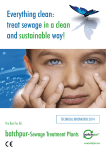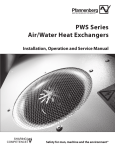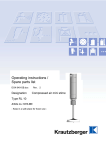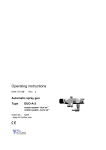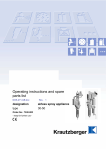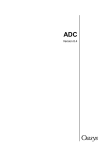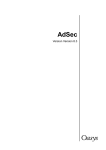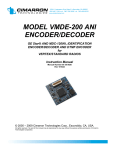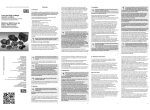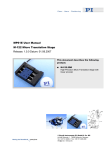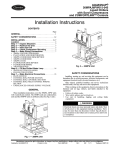Download Operating instructions and spare parts list Airless
Transcript
Operating instructions and spare parts list - keep for future use - Airless Spray Gun Typ: KS-1 KS-1D KS-1L KS-1M KS-2 Art. no.: 071. -00001 Art. no.: 20.. -00001 Art. no.: 071. -00001 Art. no.: 079. -000 Art. no.: 07.. -000 Contents Hazard and warning notes Page 3 1. Use for intended purpose 6 2. Basic design, functional principle 7 3. Startup 3.1 Preparations 8 3.2 Function test and startup 4. Operational interruptions, work breaks 9 5. Finishing work 10 6. Operating faults, spray profile errors 10 7. Replacing parts 11 8. Cleaning, maintenance 12 9. Disposal 13 10. Technical data 13 Declaration of Conformity 13 Spare parts for KS-1/KS-1L/KS-2 17/18 Spare parts for KS-1M 19/20 Spare parts for KS-1D 21/22 Accessories 24 2 Hazard and warning notes! Only start up the spray gun type: KS after carefully reading the operating instructions in full! Prevent unauthorised persons, in particular children and youths, from gaining access to the hazard zone! Always store the spray gun well out of the reach of children! In particular during work breaks and when processing hazardous substances, take measures to prevent misuse by children and youths as well as other unauthorised persons! Clean thoroughly before storing and/or transporting! Take measures to prevent accidental pulling or activation of the trigger (22 or 25 e.g. on the edge of a bench or similar)! During work breaks and after finishing work, immediately fold the safety latch (29) forward (lock) and make sure that the trigger is blocked and that no material can escape by pulling the trigger (22 or 25). During work breaks, hang the spray gun on the bracket (B) out of the reach of children! Above 4 MPa (40 bar), there is a noticeably greater kickback with increasing material pressure! Connection of the material feed may only be performed by suitably qualified personnel! Only use tubes and tube connections which can withhold the pressures and any other occurring loads! Prior to each repeat startup (e.g. after work breaks), monitor the spray gun for seal tightness (no uncontrolled material, no porous or old hoses!). Check connections, pressure hoses and wearing parts and replace if necessary! Check for material fatigue at regular intervals! Ensure that hose lines cannot fly around if they are accidentally disconnected. Route hose lines in such a way that they cannot become stuck or driven over. Always wear the protective equipment (e.g. protective clothing, goggles, breathing protection, gloves etc.) recommended by the supplier of the coating substance during maintenance, cleaning or repair work and when changing materials! Wear ear mufflers if necessary, in particular during continuous operation, when using large nozzles, and when working at high material pressures! Ensure that no parts of the body (in particular fingers) can come between the trigger (22 or 25) and handle of the main element (12)! Risk of crushing. Comply with the explosion protection regulations when using potentially flammable and explosive coating substances! Keep away from sources of ignition and open flames! Comply with the warning and hazard instructions of the supplier of the coating material and the detergent with regard to emission, fire or explosion hazard or other hazards (where applicable)! In case of doubt, consult the supplier(s) of the components in question! When mixing different components and/or when using solvents or thinning agents to make coating materials, take steps to ensure that no substances with increased hazard potential are created (e.g. flammability, explosion hazard, increased explosive tendency through spraying in air, toxicity, increased toxicity due to chemical reaction with air etc.)! Avoid increased hazard potential caused by undesired chemical reactions! In case of doubt, consult the supplier(s) of the 3 components in question! Where necessary, take protective measures and effect special notification of the particular hazard(s)! When using substances such as solvents which can generate an increased explosion potential due to atomisation or spraying in air, take protective measures and effect special notification of the particular hazard! In case of doubt, consult the supplier of the components! The compatibility of the parts of the spray gun which come into contact with the material cannot be guaranteed with all potential coating substances (see chart "Parts in contact with the material" in Section 10, Technical Data). In case of doubt, consult Krautzberger GmbH! (!) Under no circumstances should the spray jet be directed at people or animals! The jet can penetrate the skin, enter the body and force air into the organism. Risk of fatal embolism! The material jet is particularly dangerous if no airless nozzle is mounted and the jet is discharged directly from the valve seat screw! There is also the risk of poisoning when using poisonous coating substances or detergents! Preventive measures: set up an emergency first aid unit in the plant (e.g. first aid training of suitable employees). What do to in the case of an accident: Immediate measures: correct treatment of wounds. Further measures: immediate treatment by an emergency service doctor who has been informed of the substance used. Do not stand in the area of the material jet! Never direct the spray jet at electrical systems or equipment! Do not spray workpieces or surfaces which are insufficiently stable! The highpowered spray jet is powerful enough to cause parts of the workpiece or surface to fly around in the working zone. During spraying and due to rebound off the workpiece, coating material is discharged into the surrounding atmosphere. Depending on the coating material used, this can result in environmental hazards, fire and explosion risk, and health hazards. For this reason, only use spraying equipment in specially designated areas! Only work in adequately ventilated areas! If necessary, use suitable extraction systems! Ensure adequate earthing (e.g. connection to building earth)! Radiators or water pipes do not provide sufficient earth contact! During lengthy breaks in operation or when shutting down the equipment as well as prior to dismantling or the start of repair and maintenance work, close the shutoff valve at the material source and press the trigger (22 or 25) until the material pressure has fully dissipated! 4 During every - even a very brief - break in operation, push the safety lever (29) forward and check to make sure that the trigger is blocked. Adhere to the pressures and temperatures listed under "Technical Data"! If high temperatures are exceeded for a certain period (e.g. > 8 hours at > 43°C, > 10 mins. at > 48°C, or > 1 min. at > 51°C, attach suit able protective devices and post notification concerning the risk of combustion due to coating substance, and draw particular attention to risks resulting from leakage or bursting of the spray gun and the hoses and/or hose connections! If necessary, wear suitable protective clothing (e.g. goggles, gloves etc.). In the event of unforeseen occurrences, release the trigger (22 or 25) to interrupt the material flow! Then immediately push the safety catch (29) to block the trigger. Close the shutoff valve on the pump. In the event of unforeseen material discharge (e.g. due to loosening of a material hose connection or bursting of the material hose), close the shutoff valve at the material source as quickly as possible! It is advisable to mount the shutoff valve within reach of the operator of the spray gun to ensure that the unforeseen discharge of material can be stopped quickly - particularly when using hazardous substances. Ensure that neither spraying nor material discharge can be activated accidentally or by defects in the unit as long as one or more persons are in the hazard zone. Take steps to ensure that no alterations can occur or be made to the material pressure during setting and maintenance work without the knowledge or consent of the setup technician! Ensure adequate illumination of the operating zone! When using flammable and/or potentially explosive materials, ensure that a fire can be rapidly extinguished! Only use spare parts and accessories from Krautzberger GmbH! Krautzberger GmbH assumes no liability for damage if any external parts are used. The instructions and notes of EN 1953 "Spraying Equipment for Coating Substances; Safety Requirements" are to be adhered to, in particular the warning, hazard and safety notes pertaining to risks and safety requirements and/or measures. Hazards which exceed those normally expected with the use of spraying equipment have not come to our attention in the handling of the spray gun type KS or versions KS-1, KS-1D, KS-1L, KS-1M or KS-2. If, however, accidents or hazardous situations occur during practical applications, please notify us accordingly. 5 1. Use for intended purpose The airless spray gun type KS is designed to allow coating of metal, plastic, ceramics, wood and similar materials as well as other suitable surfaces. Typical coating substances are, for example, lacquers, paints, water-soluble lacquer systems, adhesives, oil, release agents etc. It is also suitable for the application of abrasive materials at operating pressures below 5 MPa (50 bar). The coating substance to be used is applied to the surface by moving the spray gun by hand over the surface to be coated and pressing the trigger at the desired point. The coating substance is fed to the spray gun in liquid form under high material pressure. The spray gun works on the airless principle - in other words, the spray jet is generated exclusively by the material pressure pressing the material through a nozzle. After being discharged from the nozzle, the spray jet takes on the shape dictated by the nozzle. It is then directed at the workpiece. The effective spray jet is not quite as wide as theoretically possible. SW = spray angle TSB = theoretical spraying width ESB = actual spraying width The particles of the spray jet reach far higher speeds than with pneumatically operated spray guns. The material throughput is correspondingly higher and the jet more concentrated (in other words, the "swirling zone" is smaller). The size and shape of the jet can only be changed by changing the nozzle. The diameter of the nozzle borehole determines the material flow volume. The size and geometry of the constantly elliptically shaped nozzle opening determine the height and width of the jet (shape of an elliptical cone). A wide range of airless nozzles are available and can be obtained from Krautzberger GmbH. The nozzle can be rotated steplessly by 360° in the axis of the spray jet and secured in any position. This allows optimum adjustment of the angle at which the jet hits the workpiece to the respective condition. The spray gun is particularly suitable for use when relatively large material volumes per time unit are to be processed. A further advantage compared to pneumatically operated spray guns is that less spraying mist is created and a far higher percentage of the material therefore reaches the workpiece. Circulation connection is also possible. 6 (i) Note The coating substances approved by the manufacturer of the coating substance for spraying may be used; however, Krautzberger GmbH offers special designs for o substances dissolved in CFC-containing solvents o abrasive or o corrosive materials. 2. Basic design, mode of operation The design of the airless spray gun type KS as well as typical equipment features and accessories are shown is the diagrams 140-0059, 140-0060, 140-0128 and 140-0064. A pump supplies the material at a pressure of max. 35 MPa (350 bar) for the versions KS1, KS-1L, KS-1M and KS-2 or max. 25 MPa (250 bar) for the version KS-1D and KS-2D (400bar for the KS-1D with stainless-steel head section) through a sufficiently pressureresistant hose to the material connection (27). Pulling the trigger (22 or 25) towards the handle of the main element (12) pushes the valve needle (16) or the needle reinforcement backwards against the pull-back pressure of the valve spring (19). The sealing ball of the valve needle or needle reinforcement lifts from the valve seat of the valve seat screw (4), thus releasing the material flow to the material nozzle (102), from which the material is sprayed in the form of an elliptical cone jet. The volume of material discharged depends solely on the nozzle size and the material pressure. (!) Warning note! In the risk or the event of an accident, the spray jet can be shut down quickly by releasing the trigger (22 or 25). The airless spray gun type KS is supplied in aluminium as standard; the parts coming into contact with the material are available in stainless steel on request. Order/Article nos. for the airless spray gun type KS Material connection Version rigid (without material nozzle) swivel rigid short trigger (22) swivel long trigger (25) Article no. KS-1 (standard version) 0710-090-0522 0712-090-1128 KS-1D (processing of thick substances) 2007-090-2671 2013-090-1036 KS-1L (long trigger) 0711-090-0526 0713-090-0874 KS1M (material pipe to handle) KS-2 (circulation connection) 0798-090-0531 0718-090-.... 0720-090-.... 0799-090-0535 0719-090-.... 0721-090-.... (i) Notes The version KS-1D is equipped with material ducts with enlarged cross-section. Highly viscous materials can be processed using appropriate material nozzles. During lengthy use, fatigue is alleviated by the favourable power transmission (version KS-1L) or the shift in the centre of gravity towards the handle ((i.e. towards the back) in the version KS1M). 7 In the version KS-2, the coating substance can be circulated through the head section. Circulation connection is recommended, for example, when using coating substances which have a tendency to settle or materials whose temperature has to be kept constant. A swivel-type material connection facilitates handling of the spray gun, as the hose/hoses do not have to be turned when the user turns the gun. 3. Startup 3.1 Preparations > Push the safety catch (29) forward and make sure that the trigger (22 or 25) can no longer be activated. > If necessary, install a suitable spring (19) for 25MPa > Install the material nozzle (102) > Earth the spray gun > Connect the pressure hose to the material connection (27) - or, in the case of circulation connection, connect both pressure hoses to the material connections (27) > Prepare the coating substance and the accessories for material feed > Switch on the material pump > Set the material pressure on the regulator or on the material pump or in the return section of the circulation line > Open the shutoff valve at the material source No material should be discharged at any point. (!) Caution! The material feed should only be connected up by suitably trained personnel! Ensure that the pressures and temperatures listed under "Technical Data" are not exceeded! Installation or replacement of the nozzles, springs etc. must be performed by suitably trained personnel! 3.2 Function test and startup > > > > > > Push the safety catch (29) upwards (unlock) Point the nozzle of the spray gun at a test surface Start the spraying process by pressing the trigger (22 or 25) Assess spray profile and, if necessary, after securing the gun using the safety catch (push forwards), change the nozzle (see Krautzberger GmbH order catalogue for available airless nozzles) If necessary, loosen the nozzle nut (1) again Turn the material nozzle (102) in the desired direction (it can be rotated by 360°) Tighten the nozzle nut (1) Push the safety catch (29) upwards (unlock) Guide the spray jet across the workpiece using even movements Terminate spraying by releasing the trigger (22 or 25) > > > > > > (i) Notes Only use accessories from Krautzberger GmbH! Only use sufficiently sturdy hoses! Check (and, if necessary, replace) older hoses before starting up the spray gun. 8 Only use hoses which fit in the hose connections; ensure correct fit and seal-tightness! It is advisable to rinse the spray gun through using a suitable detergent prior to first startup (effect spraying using detergent until it is discharged clear). To ensure that particles do not block the nozzle, it is advisable to clean the coating substance through a material filter in front of the material connection (27). High-pressure material filters are available from Krautzberger GmbH. In order to achieve uniform layer thickness and spray profile when using high-grade coatings, it is advisable to apply the substance in cross-wise fashion; in other words, first coat the surface in horizontal lines and then in vertical lines (or vice-versa). Material feed is effected via a pump. A circulation connection is recommended, for example, when using settling coating substances or for materials whose temperature has to kept constant. In airless units (unlike pneumatic spray guns), it is generally not possible to change the spray profile by adjusting the nozzle. If a different spray profile is desired, you must change the airless nozzle. The spray angle can be altered by using adjustable material nozzles. The spray profile depends on, among other factors, the viscosity of the coating substance and can be altered via the material pressure. If changing the material pressure does not create an optimum spray profile, it is advisable to repeat the trial using a different material nozzle. (!) Danger When changing the airless nozzles, it is essential that you not only push the safety catch (29) forwards and check that the lever is blocked on the trigger (22 or 25) but also that you close the material feed! Although no material can escape from the valve seat screw (4) when the trigger (22 or 25) is blocked by the safety catch (29), accidental (or other) pressing of the trigger during nozzle changing can result in danger to life and limb of all persons in the area of the spray jet. In such an event, the material jet is discharged from the front opening of the valve seat screw (4) at high speed. The jet can penetrate the skin, enter the body and force air into the organism. Risk of fatal embolism! There is also the risk of poisoning when using poisonous coating substances or detergents! 4. Interruptions to operation, work breaks During operational downtimes - e.g. work breaks: > > > Close the shutoff valve at the material source Switch off the pump (where applicable) Push the safety catch (29) forwards (lock) 9 > > Pull the trigger (22 or 25) to check that the safety catch (29) blocks the trigger and no material can be discharged Hang the spray gun on a hook (using the bracket (B)) or some other suitably robust fastening device In all cases, close off the material feed, and ensure that unauthorised persons - in particular children and youths - cannot gain access to the spray gun. 5. Finishing work Releasing the trigger (22 or 25) ends the spraying process. If work is not to be continued, proceed as follows: > Close the shutoff valve at the material source > If necessary, switch off the pump > Clean the spray gun by filling a suitable detergent (e.g. one recommended or prescribed by the supplier of the coating substance) into the/a material container and opening the shutoff valve to convey it through the pump, the material hose/hoses and the spray gun until it is discharged clear. > Push the safety catch (29) forwards (lock) > Close the shutoff valve on the pump > Switch off the material pump > Use suitable means to clean parts on which material is still present > Store the spray gun in a place inaccessible to unauthorised persons (in particular children and youths). If necessary, unscrew the material hose/hoses, clean any parts which have not been cleaned, disconnect the earth, and lock the spray gun away. (i) Notes Ensure that no residues of toxic, flammable or explosive material or detergent remain in the spray gun (avoidance of hazard during storage or transport). Dispose of any surplus coating substance (e.g. residual amounts) which is not to be poured back into the storage container in line with the instructions of the producer of the coating substance. If necessary, effect disposal in a special waste site. For cleaning of the spray gun and all accessories such as hoses, filters etc. which come into contact with the material: o o use the detergent recommended or prescribed by the producer of the coating substance and then dispose of the detergent in line with the instructions of the producer of the coating substance or those of the supplier of the detergent. If necessary, effect disposal in a special waste site. 6. Operating malfunctions, spray profile defects If the spray profile is unsatisfactory, check whether the material nozzle is contaminated. If necessary, insert, clean or replace the material filter. 10 7. Changing parts Valve needle (KS-1, KS-1L, KS-1M and KS-2) > Unscrew the valve sealing screw (20) > Remove the spring (19) > Unscrew the nozzle nut (1) > Unscrew the valve seat screw (4) > Push the valve needle, cmpl. (15) out towards the back using a suitably shaped (but not sharp-edged) object made (for example) of wood or plastic. The back end of the valve needle, cmpl. (15) is pushed from the back section of the main element (12). > Completely pull out the valve needle, cmpl. (15) > Unscrew the valve needle (16) from the needle bolt (18) > Screw the needle pusher (17) onto the new valve needle (16) > Exactly set the length (70 mm +0.2) > Screw the needle bolt (18) onto the valve needle (16) and > counter against the needle pusher (17) Needle reinforcement (KS-1D) > Unscrew the nozzle nut (1) > Unscrew the valve seat screw (4) > Loosen and unscrew the needle reinforcement (50) from the lock nut (51) If only the needle reinforcement (50) is to be replaced: > Screw on the new needle reinforcement (50) > Set a dimension of 24.5 mm using a calliper gauge and > counter using the lock nut (51) If parts (17, 18, 19 and 52) are also to be replaced: > Remove the needle reinforcement (50) and lock nut (51), then > unscrew the sealing screw (20) > Remove the spring (19) > Push parts (17, 18 and 52) out towards the back using a suitably shaped (but not sharp-edged) object made (for example) of wood or plastic The back end of the needle bolt (18) is pushed from the back section of the main element (12). > Completely pull out parts (17, 18 and 52). These parts are generally not dismantled any further Needle packing (KS-1, KS-1D, KS-1L and KS-2) After removing the valve needle, cmpl. (15) - or, in the case of KS-1D - the parts (17 to 19 and 50 to 52): > Loosen the hex nut (14) and remove, > together with the insulation washer (13) > Pull the head section (6) towards the front and out of the main element (12) > Pull the insulating sleeve (11) and the insulating washer (9) off the seal screw (10) > Unscrew the seal screw (10) from the head section (6) > Remove the packing parts, each consisting of two gaskets (7) and two cup collars (8). (Use a wire hook to pull out the packing parts. Take care not to damage any threads!) Then thoroughly clean all reusable parts. Assembly: > Install new packing parts, each consisting of two gaskets (7) and two cup collars (8), in the described sequence and direction; do not damage the sealing lips! Do not use pointed or sharp-edged objects during installation! > Loosely screw the seal screw (10) into the head section (6) > Push the insulating sleeve (11) and the insulating washer (9) over the seal screw (10) 11 > > > > > > > > Push the head section (6) with seal screw (10), insulating sleeve (11) and insulating washer (9) into the borehole of the main element (12) Push the insulating washer (13) over the seal screw (10) Screw the head section (6) to the seal screw (10) using the hex nut (14), but do not tighten! Insert the valve needle, cmpl. (15) into the main element from the back and push forwards up to the stop (for KS-1D, see replacement of needle reinforcement) Push the spring (19) over the needle bolt (18) into the main element (12) Tighten the valve sealing screw (20) Only then should you tighten the seal screw (10) until there is noticeable resistance and counter by tightening the hex nut (14) Procedure for replacing the needle packing of the spray gun type KS-1M: > First loosen the two union nuts (41) > Then pull the material pipe (42) from the connecting nipples (after bending it slightly) Then proceed as for needle packing replacement in the other KS types. Valve seat screw and material nozzle > Unscrew the nozzle nut (1) > Remove the material nozzle (102) and the gasket (3) > Unscrew the valve seat screw, cmpl. (4) together with gasket (5) > Pull the gasket (5) from the valve seat screw, cmpl. (4) Assembly, unless already described otherwise, is performed in the reverse order. Lightly lubricate the moving parts using a suitable grease, e.g. article no. 7026-500 from Krautzberger GmbH (supplied in 250 g cans). Clean soiled parts, and replace parts which no longer function properly. Ensure correct seat of gaskets! (i) Notes Always change the valve needle (16) (or in the KS-1D the needle reinforcement (50)) and the valve seat screw (4) together! Following assembly of the parts (16) to (18), the valve needle (16) should project exactly 70 mm (or as close as possible) from the needle pusher (17). An overlength of up to 0.2 mm is admissible; short lengths result in inadequate valve seat. Occasionally check the moving parts for free range of motion and lubricate with grease if necessary! 8. Cleaning, maintenance, material change Wearing parts such as material nozzle (102), valve seat screw (4) and valve needle (16) or needle reinforcement (50), gaskets (3, 5, 7 and 26) and cup collars (8) as well as springs (19) should be checked at appropriate intervals and replaced if necessary (e.g. if the valve needle or needle reinforcement does not close sufficiently or if there is uncontrolled discharge of coating substance). (!) Danger During maintenance and repair work and when changing the nozzle, first close the shutoff valve at the material source and then press the trigger (22 or 25) until the spray gun is without pressure. Always wait until the pressure has dissipated!. Then push the safety catch (29) forwards (lock) and check that the safety catch (29) blocks the 12 trigger and that no more material can be discharged by pressing the trigger (22 or 25). See hazard and warning notes! (i) Notes The spray gun is never to be dismantled into its individual parts except when this is necessary for repair or maintenance purposes. When cleaning and during material change, the gun should be rinsed through thoroughly using a detergent recommended or prescribed by the supplier of the coating substance until it is discharged clear. The spray gun should never be completely immersed in detergent! This could destroy the gaskets and rinse out the lubricant. During lengthy breaks in operation, the spray gun should be rinsed through with detergent, left to dry, and stored in a suitable place until it is to be used again. Do not clean material nozzles and valve seat screw using hard, sharp-edged objects! (For cleaning of the nozzles, we recommend the flat brush, article no. 7025-015, or nozzle cleaning needles (see list of accessories, no. 140-0064) from Krautzberger GmbH.) A cloth soaked in detergent is recommended for external cleaning. 9. Disposal Following dismantling of the spray gun type KS, the metal parts can be sorted and forwarded to a recycling process; the non-metal parts should be disposed of as special waste. 10. Technical data Operating pressures / Operating temperature Max. material pressure (KS-1, KS-1L, KS-1M and KS-2): Max. material pressure (KS-1D, KS-2D): Max. material pressure (KS-1D st.st. head section): Max. material temperature: 50°C Connections Material connection: G1/4 IG Weight (without add-on parts) KS-1, KS-1L, KS-1D and KS-2: KS-1M: approx. 470 g approx. 580 g 35 MPa (350 bar) 25 MPa (250 bar) 40 MPa (400 bar) Material spray zone Angle of material jet in front of nozzle: up to approx. 110° depending on nozzle Length of material jet in front of nozzle: up to 5 metres depending on nozzle and material pressure Length of material jet with removed nozzle: up to 20 metres Noise emission Continuous sound pressure level: nozzle-dependent, 60 to 90 dB(A) Load due to vibrations 13 Acceleration: < 2.5 metres/sec.2 Available airless nozzles: A wide range of airless nozzles are available from Krautzberger GmbH, and we will be happy to send you more detailed information on request. The order catalogue contains an overview of the available nozzles. The nozzles differ in their equivalent diameter and spraying angle. Graduations of equivalent diameters [mm]: 0.13, 0.18, 0.23, 0.28, 0.33, 0.38, 0.41, 0.46, 0.51, 0.53, 0.61, 0.66, 0.74, 0.79, 0.91, 1.04, 1.10, 1.22, 1.32, 1.57, 1.83 and 2.16 Possible graduations of spraying angle [°]: 5, 10, 15, 25, 35, 40, 50, 60, 65, 73, 80, 95 and 110 The description "equivalent diameters" comprises dimensions for circular boreholes which correspond to the elliptical openings of the nozzles with regard to throughput volume. Throughput volumes in output tables expressed in l/min. at 7 MPa (70 bar) refer to water. These figures vary with materials of different density and/or viscosity. The effective spraying width (which depends on the spraying angle) is measured using water at a pressure of 10 MPa (100 bar) at a distance of 30 cm from the workpiece. Parts in contact with the material Standard version Part designation Nozzle nut Material nozzle Gasket Valve seat screw Valve needle Needle reinforcem. Gasket Head section Head section for circulation Gasket Material connection, rigid Material connection, swivel Version on request Material Art. no Material Art. no. stainless steel tungsten carbide (TC) polyoxymethylene (POM) stainless steel + TC 0700-040-1844 0706-080-0015 stainless steel 0707-080-0016 stainless steel + TC stainless steel + TC Viton aluminium 0706-070-0777 2007-080-0031 0700-010-0049 0706-080-0514 stainless steel 0707-070-2300 stainless steel 0765-080-0515 aluminium 0714-080-0687 stainless steel 0773-080-.... NBR 0700-010-0056 stainless steel 0700-040-1653 stainless steel 0700-090-0555 0700-050-.... 0700-010-0048 Special equipment o Nozzle nut, long The long nozzle nut (101) protects the material nozzle against damage. o Fine-spray nozzle The fine-spray nozzle (103) generates a particularly fine spray jet. 14 o Pre-atomiser nozzle The pre-atomiser nozzle (104) accelerates the material flow and helps to improve the spray profile. This means that the operator can work using (in some cases) considerably reduced material pressure and/or larger material nozzle. A large material nozzle - and an accordingly slower material flow speed - reduces the risk of blockage. The pre-atomiser nozzle should be chosen to suit the size of material nozzle (see table of airless nozzles in the Krautzberger GmbH order catalogue). The pre-atomiser nozzle (104) is mounted directly behind the material nozzle (102) instead of the gasket (3). o Adjustable material nozzle The adjustable material nozzle (105) allows adjustment of the spray angle. o Nozzle reversal switch The nozzle reversal switch (107) can be used to rapidly remove a nozzle blockage. The nozzle is turned in the retainer by 180° and the ma terial feed briefly opened until the blockage has been flushed away. o Material filter A material filter can be installed in front of the material connection (27) to prevent blockage. This is particularly advisable when using small airless nozzles. The filter screen size should be chosen to suit the nozzle size (see table of airless nozzles in the Krautzberger GmbH order catalogue). o Nozzle extensions Nozzle extensions are particularly suitable for the coating of cavities such as pipes, canisters, cans or other containers. In many cases it is possible to adapt the length and shape of the nozzle extension to the special requirements on the customer's premises. Ready-made nozzle extensions are also available (see Krautzberger GmbH order catalogue). (!) Caution When working with a nozzle extension, note that explosive mixtures can be created extremely easily due to the interaction of flammable materials and air in cavities! Ensure adequate ventilation! 15 Declaration of conformity under the terms of the EC Directive 89/392 EEC and the amendment directives 91/368/EEC and 93/44/EEC Krautzberger GmbH, Stockbornstrasse 13, D-65343 Eltville Design of unit: Type designation: Versions: Make: Serial nos.: Airless spray gun KS KS-1, KS-1D, KS-1L, KS-1M and KS-2 Krautzberger GmbH 0700-000 and 2000-000 The spray gun type KS and the versions KS-1, KS-1D, KS-1L, KS-1M and KS-2 were developed, designed and produced in compliance with the EC Directive 89/392/EEC. The following harmonised standards were applied: o EN 292, Safety of Machines, Plant and Equipment o EN 1953, Spraying Equipment for Coating Substances, Safety Requirements (German version prEN 1953: 1995) The following documents are fully available: o Overall diagram of the spray gun type KS and the versions KS-1, KS-1D, KS-1L, KS-1M and KS-2 o Detailed and complete diagrams for the checking of compliance of the spray gun type KS and the versions KS-1, KS-1D, KS-1L, KS-1M and KS-2 with the basic safety and health safety requirements o A list of the basic requirements from EC Directives, standards and specifications applied during the development, design and production of the spray gun type KS and the versions KS-1, KS-1D, KS-1L, KS-1M and KS-2 o A description of the solutions to prevent hazards arising from use of the spray gun type KS and the versions KS-1, KS-1D, KS-1L, KS-1M and KS-2 o A copy of the operating instructions Head of design at Krautzberger GmbH 16 Spare parts list for the airless spray gun, type KS-1/KS-1L/KS-2 Item Article no. Designation 1 * 3 4 4 * 5 6 6 6 6 * 7 * 8 9 10 11 12 12 13 14 15 15 16 16 17 18 19 19 20 21 22 23 24 25 *26 27 0700-040-1844 0700-010-0048 0706-080-0015 0707-080-0016 0700-010-0049 0706-080-0514 0765-080-0515 0714-080-0687 0773-080-... 0700-010-0043 0700-010-0044 0700-010-0052 0700-040-1648 0700-010-0050 0710-080-0591 0711-080-0592 0700-010-0051 0700-040-0808 0706-070-0852 0706-070-2301 0706-070-0777 0707-070-2300 0700-070-0727 0700-040-0089 0700-020-0004 0700-020-0005 0700-040-1650 0706-040-1644 0706-040-1862 0700-030-1373 0707-040-1676 0707-040-1662 0700-010-0056 0700-090-0555 27 27 28 29 30 31 *32 0700-040-1653 0706-040-1669 0700-040-1645 0700-040-1643 0700-040-1646 0700-040-1647 0700-010-0042 0700-010-0632 Nozzle nut Gasket Valve seat screw, cmpl., tungsten carbide (standard) Valve seat screw, cmpl., stainless steel Gasket Head section, cmpl., aluminium Head section, cmpl., stainless steel Head section, cmpl., aluminium, for circulation Head section, cmpl., stainless steel, for circulation Gasket (2 pcs) Cup collar (2 pcs) Insulating washer Seal screw Insulating sleeve Main element with handle piece Main element without handle piece Insulating washer Hex nut Valve needle, cmpl., tungsten carbide (standard) Valve needle, cmpl., stainless steel Valve needle, tungsten carbide (standard) Valve needle, stainless steel Needle pusher Needle bolt Valve spring, for operation up to approx. 250 bar Valve spring, for operation up to 350 bar Valve sealing screw Trigger shaft Trigger, short Screw Trigger shaft Trigger, long Gasket (for circ. 2 pcs) Material connection, swivel-type, stainless steel (for circ. 2 pcs) Material connection, rigid, brass (for circ. 2 pcs) Material connection, rigid, stainless steel (for circ. 2 pcs) Washer Safety catch Spring washer Screw Packing, cmpl. (item 7, 8) Gasket set * Contained in the gasket set. Please always state article no. and designation when ordering! 17 KS-1/KS-1L/KS-2 18 Spare parts list for the airless spray gun, type KS-1M Item Article no. Designation 1 3 4 4 * 5 6 6 * 7 * 8 9 10 11 12 12 13 14 15 15 16 16 17 18 19 19 20 21 22 23 24 25 * 26 27 28 29 30 31 * 32 40 41 42 43 Nozzle nut Gasket Valve seat screw, cmpl., tungsten carbide (standard) Valve seat screw, cmpl., stainless steel Gasket Head section, cmpl., aluminium Head section, cmpl., stainless steel Gasket (2 pcs) Cup collar (2 pcs) Insulating washer Seal screw Insulating sleeve Main element with handle piece Main element without handle piece Insulating washer Hex nut Valve needle, cmpl., tungsten carbide (standard) Valve needle, cmpl., stainless steel Valve needle, tungsten carbide (standard) Valve needle, stainless steel Needle pusher Needle bolt Valve spring, for operation up to approx. 250 bar Valve spring, for operation up to 350 bar Valve sealing screw Trigger shaft Trigger, short Screw Trigger shaft Trigger, long Gasket (2 pcs) Material connection, swivel-type Washer Safety catch Spring washer Screw Packing, cmpl. (item 7, 8) Cutting ring (2 pcs) Union nut (2 pcs) Material pipe Double nipple Gasket set * 0700-040-1844 0700-010-0048 0706-080-0015 0707-080-0016 0700-010-0049 0706-080-0514 0765-080-0515 0700-010-0043 0700-010-0044 0700-010-0052 0700-040-1648 0700-010-0050 0798-080-0621 0799-080-0608 0700-010-0051 0700-040-0808 0706-070-0852 0706-070-2301 0706-070-0777 0707-070-2300 0700-070-0727 0700-040-0089 0700-020-0004 0700-020-0005 0700-040-1650 0706-040-1644 0706-040-1862 0700-030-1373 0707-040-1676 0707-040-1662 0700-010-0056 0700-090-0555 0700-040-1645 0700-040-1643 0700-040-1646 0700-040-1647 0700-010-0042 0796-030-0850 0796-030-0851 0796-040-0254 0796-040-0130 0796-010-0632 * Contained in the gasket set. Please always state article no. and designation when ordering! 19 KS-1M 20 Spare parts list for the airless spray gun, type KS-1D Item Article no. Designation 1 * 3 4 * 5 6 6 * 7 * 8 9 10 11 12 12 13 14 17 18 19 20 23 24 25 * 26 27 27 28 29 30 31 * 32 50 51 52 Nozzle nut Gasket Valve seat screw, cmpl., tungsten carbide Gasket Head section aluminium (250bar) Head section stainless steel (400bar) Gasket (2 pcs) Cup collar (2 pcs) Insulating washer Seal screw Insulating sleeve Main element, "Krautzberger" Main element, "neutral" Insulating washer Hex nut Needle pusher Needle bolt Valve spring Valve sealing screw Screw Trigger shaft Trigger Gasket (for circ. 2 pcs) Material connection, swivel-type (for circ. 2 pcs) Material connection, rigid (for circ. 2 pcs) Washer Safety catch Spring washer Screw Packing, cmpl. (item 7, 8) Needle reinforcement, cmpl., tungsten carbide Nut Threaded needle Gasket set 0700-040-1844 2000-010-0533 2007-080-0495 2000-010-0533 2007-040-9165 2000-080-3126 0700-010-0043 0700-010-0044 0700-010-0052 0700-040-1648 0700-010-0050 2007-080-0592 2007-080-0649 0700-010-0051 0700-040-0808 0700-070-0727 0700-040-0089 0700-020-0005 0700-040-1650 0700-030-1373 0707-040-1676 0707-040-1662 0700-010-0056 0700-090-0555 2007-040-1669 0700-040-1645 0700-040-1643 0700-040-1646 0700-040-1647 0700-010-0042 2007-080-0031 2007-030-2913 2007-070-0640 2000-010-0661 * Contained in the gasket set. Please always state article no. and designation when ordering! 21 KS-1D 22 List of accessories for airless spray gun, type KS Item Article no. Designation 101 *102 *103 *104 *105 *106 107 0700-040-1846 0700-050-... 0700-050-... 0700-050-... 8222-050-... 8222-050-... 8222-030-2041 Nozzle nut, long Material nozzle Fine-spray nozzle Pre-atomiser Material nozzle, adjustable Nozzle core for nozzle reversal switch Nozzle reversal switch (without nozzle core) 0700-030-2038 Set of nozzle cleaning needles, size 0, for nozzles up to 0.23 mm dia. Set of nozzle cleaning needles, size 1, for nozzles up to 0.33 mm dia. Set of nozzle cleaning needles, size 4, for nozzles from 0.38 mm dia. 0700-030-2039 0700-030-2040 Always state article no. and designation when ordering! * Please additionally specify desired type and size of these articles when ordering! 23 24
























